Deep Analysis
Chemical Reactions

Deep Analysis
Use the questions below to go deeper into the scientific concepts and applications of each Investigation. Students also have a copy of every question, but do not have the answers.
Investigation 1
- When students have finished their Investigation, discuss the data in Table A.
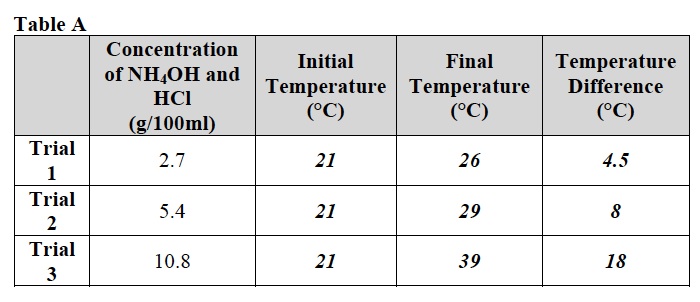 Ask students to complete the analysis of their data by drawing a best fit line in problem 1d of the Analysis section in their Student Data Record.
Ask students to complete the analysis of their data by drawing a best fit line in problem 1d of the Analysis section in their Student Data Record.
Note: If necessary, students should refer to the procedures for Determination and Graphing of Independent and Dependent Variables Drawing of a Best Fit Line and Graphing of Independent and Dependent Variables
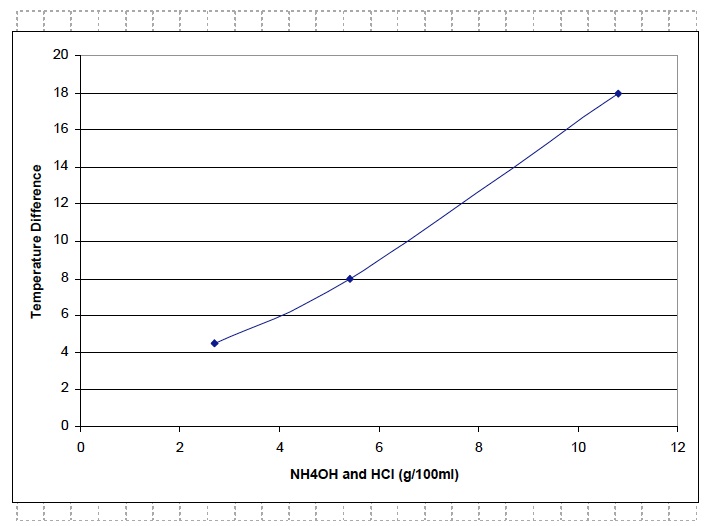
Ask students to analyze their graphs by answering the question. Use the suggested response below to guide students’ answers.
- How does the concentration of the reactants affect the amount of heat produced by the reaction? As the concentration of ammonium hydroxide (NH4OH) and hydrochloric acid (HCl) increased from 2.7 g/100ml to 5.4 g/100 ml to 10.8 g/100 ml, the temperature difference between the initial and final temperatures of the reaction increased from 4.5° C to 8° C to 18° C. Therefore as the amount of each reactant increased, the amount of heat produced also increased.
Ask students to think about the signs of a chemical change and answer the following question. Use the suggested response below to guide students’ answers.
- Since the appearance of the liquids in the reaction did not change after both reactants were added to the cup, what other sign suggested that a chemical change occurred? The release of heat is one of the common signs of a chemical change. In each of the Trials, there was an increase in the temperature of the liquid after both reactants were combined. The increase in temperature suggested that heat was released as a result of a chemical change or chemical reaction.
Based on the data collected in the Investigation, ask students to answer the Conclusion questions then compare their conclusions with their predicted answers. Use the suggested responses below to guide students’ answers.
- What happens to the reacting chemicals in a chemical reaction? The reacting chemicals were used up and converted to the products.
- What is produced in a chemical reaction? The products water, ammonium chloride, and heat were produced.
- How do you know that a chemical reaction has occurred? The release of heat is a common sign of a chemical change.
Investigation 2
When students have finished their Investigation, discuss the data in Table C.
Note: For each Trial, students should use the measured diameter of the inflated balloon to calculate the volume of hydrogen gas produced.
Direct students to the Analysis section in their Student Data Record for instructions on using the formula for the volume of a sphere.
Note: Students should calculate the volume of the inflated balloon for every Trial and enter the volumes in Table C.
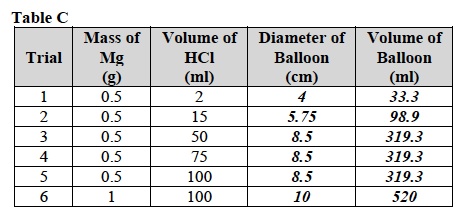
Ask students to complete the analysis of their data by graphing their data from Table C in their Student Data Record using the procedure for Graphing of Independent and Dependent Variables.
Note: Students should connect the data points for Trials 1 through 5 with straight lines and not draw a best fit line.
Note: Students should plot the data point from Trial 6 and not draw a line through it.
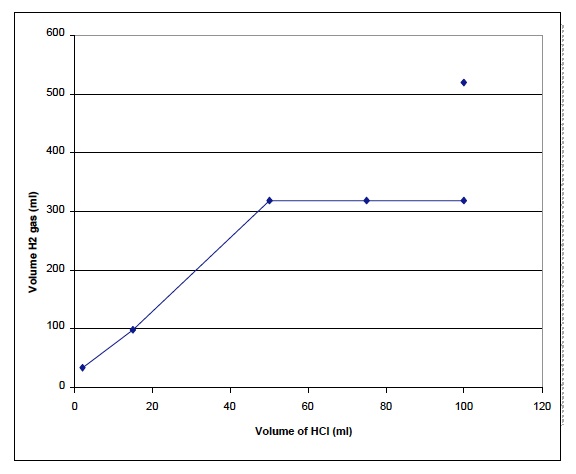
Ask students to analyze the graph in the range of hydrochloric acid volumes between 2 and 50 ml then answer the questions in problems 3 and 4 of the Analysis section in their Student Data Record.
- What is the relationship between the volume of hydrochloric acid added as a reactant and the volume of hydrogen gas (H2) that was produced as a product? Student answers will vary. For every increase in the volume of hydrochloric acid, the volume of hydrogen gas increases.
- In this range of hydrochloric acid volume, do you think that the hydrochloric acid or the magnesium is greater in amount? Why? (Hint: Remember that you looked into the flask after Trials 1-3 were complete to observe if any magnesium remained.) Student answers will vary. In this range of hydrochloric acid (HCl) volume, the magnesium metal (Mg) is in greater amount because magnesium metal (Mg) was observed to remain after the reactions were complete.
Ask students to analyze the graph in the range of hydrochloric acid (HCl) volumes between 50 and 100 ml then answer the questions in their Student Data Record.
- What is the relationship between the volume of hydrochloric acid added as a reactant and the volume of hydrogen gas that was produced as a product? Student answers will vary. For every increase in the volume of hydrochloric acid used as a reactant, the volume of hydrogen gas remained the same.
- In this range of volumes of hydrochloric acid, do you think that the hydrochloric acid or the magnesium is greater in amount? Why? (Hint: Remember that you looked into the flask after Trials 3-5 were complete to observe if any magnesium remained.) Student answers will vary. In this range of hydrochloric acid volume, the hydrochloric acid is in greater amount because no magnesium was observed to remain after the reactions were complete.
Ask students to read the Background in their Student Data Record and discuss the case where one reactant is present in a greater amount than the other.
Ask the students about a chemical reaction in which one reactant remains unreacted. Ask students to answer the questions in their Student Data Record.
- If one of the reactants is completely consumed but some of the second reactant remains unreacted, which reactant limits the amount of products that can be produced? Why? Student answers will vary. The reactant that is completely consumed limits the amount of the products that can be produced because there is no more of that reactant left.
- Analyze the graph in the range of hydrochloric acid volumes between 50 and 100 ml. Why did the diameter of the balloon and the volume of hydrogen gas remain unchanged in this range of hydrochloric acid volumes? Student answers will vary. The magnesium was completely consumed in this range of hydrochloric acid volumes because the hydrochloric acid was present in a greater amount.
Ask students to analyze the graph for the two data points for the reactions of 0.5 g of magnesium and 1 g of magnesium metal with 100 ml of hydrochloric acid. Ask students to answer the questions in their Student Data Record.
- Compare the volume of hydrogen produced by the reactions of 0.5 g and 1 g of magnesium with 100 ml of hydrochloric acid. Which reaction produced a greater volume of hydrogen H2? Student answers will vary. The reaction using 1 g of magnesium produced a greater volume of hydrogen gas.
- Why did one reaction produce more hydrogen H2 gas than the other? Student answers will vary. More hydrogen was produced in the reaction using 1 g of magnesium because unreacted hydrochloric acid remained.
- In the reaction of 100 ml of hydrochloric acid and 0.5g of magnesium, which reactant was present in the lesser amount? Student answers will vary. The magnesium was present in the lesser amount because the 0.5 g of magnesium was used up. When a greater amount of magnesium, 1 g, was added to 100 ml of hydrochloric acid, more hydrogen gas was produced suggesting that an excess of hydrochloric acid remained after the 0.5 g of magnesium was used up.
Write the chemical equation on the board and ask students to complete number 12 in their Student Data Record.
- What are the two products of the chemical reaction that you have observed? Circle the products Magnesium chloride (MgCl2) and hydrogen gas (H2).

Based on the data collected in the Investigation, ask students to answer the following questions, and compare their conclusions with their predicted answers.
- Are the reactants always completely used up in a chemical reaction? If the reactants are present in equal amounts, then each reactant will be completely used up.
- Does the matter making up the reactants disappear? The matter making up the reactants does not disappear, it is found in the products of the reaction.
- What happens if there is more of one reactant than the other reactant? If there is more of one reactant than the other reactant, then it will not be completely used up in the reaction.
- How do you know when a chemical reaction has stopped? No more products are produced when a chemical reaction has stopped.
Investigation 3
When students have finished their Investigation, direct their attention to their data in Table B.
For each Trial, instruct students to convert the reaction time as it is recorded in Table B from minutes and seconds to seconds. The reaction times in seconds should be entered in the last column of Table B.
Note: A sample calculation is shown in step 1 of the Analysis section in their Student Data Record.
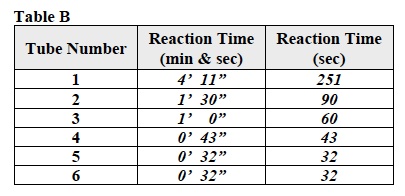
Based on the data in Table B, discuss the questions in problems 3-8 of the Analysis section in students’ Student Data Record. Students should refer to the equation in their Student Data Record.

- Which reactant was added using a different volume for each reaction? Acetone (CH3COCH3) was added.
- Did the volume of that reactant increase or decrease for reactions 1 to 6? The volume of reactant increased.
- Which chemical was the other reactant in the reaction? Iodine (I2) was the other reactant in the reaction.
- Was the other reactant added using a different volume for each reaction? No, the same amount of reactant was added for each Trial.
- Which chemical was the catalyst in the reaction? The catalyst was hydrochloric acid (HCl).
- Was the catalyst added using a different volume for each reaction? No, in each Trial the same volume of catalyst was added.
Based on the data in Table B, discuss the questions in problems 9-12 in students’ Student Data Record. Students should refer to the equation in their Student Data Record.
- Reaction time was measured by following the disappearance of which reactant? Iodine
- What evidence supports the idea that the iodine (I2) was consumed in the reaction? The color of the reaction just after the iodine was added was reddish brown because of the iodine. At the end of the reaction, it was colorless suggesting that the iodine had been consumed in the reaction.
- How was the disappearance of the iodine (I2) measured? The disappearance was measured by measuring the color change in the reaction. This was done by measuring the absorbance of the reaction at 460 nanometers using the spectrophotometer.
Ask students to answer the Investigation by completing the following question.
- What was the purpose of this Investigation? Student answers will vary. The purpose of the investigation was to investigate what effect increasing the amount of one reactant had on the reaction time.
Ask students to graph their data from Table B.
Note: Students should connect the data points with a series of straight lines and not draw a best fit line. If necessary, refer students to the procedure for the Graphing of Independent and Dependent Variables.
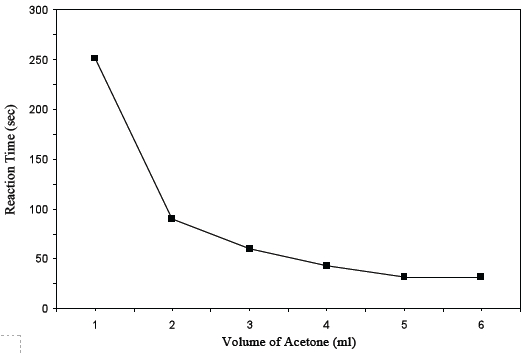
Based on their graph of the data, ask students to discuss the questions in problems 14-17 about the change in reaction time.
- Why was the graph created using the different volumes of acetone and the reaction time? Student answers will vary. The graph was created using the different volumes for acetone and the reaction rate since the acetone (CH3COCH3) was the independent variable and the reaction rate was the dependent variable. The graph illustrates how the change in the amount of one reactant, acetone, affects the reaction time.
- Did the reaction time for Trials 1 to 6 increase or decrease? The reaction time decreased.
- Which reactant caused the reaction time to change? Acetone (CH3COCH3)
- How would you describe the relationship between the amount of the acetone reactant and the reaction time? As the volume of acetone increased, the reaction time decreased.
Discuss students’ answers to the questions in problems 18 and 19 in their Student Data Record. Ask students to refer to the equation.
- As the products were made what happened to the iodine? Student answers will vary. As the products were made, the iodine was consumed.
- What happened to the products as the amount of the reactant, acetone, was increased? Student answers will vary. The rate of production of the products increased as the amount of acetone (CH3COCH3) increased.
Based on the data collected in the Investigation, ask students to answer the following questions, and compare their conclusions with their predicted answers.
- Do chemical reactions always produce products at the same rate? No, the rates of chemical reactions can be different.
- What factors affect how fast a chemical reaction takes place? The amount of a reactant can affect how fast a chemical reaction takes place.
- If you change the amount of a reactant, what happens to the time it takes to complete a chemical reaction? Adding more of one of the reactants compared to the other reactants results in a faster reaction time (decreased reaction time).
GET FOCUSED
Instruct students to complete the Focus Question in their SDRs then discuss it as a class. Use the suggested response below to guide students’ answers.
- In a chemical reaction, what is the relationship among the reactants, the products, and the time it takes to complete the reaction? As the amount of a reactant increases, the reaction time decreases. As the time decreases, this can be measured as an increase in the rate of disappearance of the reactants and an increase in the rate of production of the products. Therefore the more reactants added to a reaction, the more products that will be produced, and the faster they will be produced.
Comprehension Check
The Comprehension Check is designed to summarize the Core Experience Learning Lab and provide the teacher with an informal way to assess students’ understanding of the big ideas.
If time permits, ask your students to answer each Focus Question below. Use the suggested responses below to guide students’ answers.
- In a chemical reaction, what is the relationship between the amount of reactants and the amount of products? As the amounts of the reactants increase, the amounts of the products produced also increase. In Investigation One, as the amounts of the NH4OH and the HCl increased, the amount of heat produced increased.
- In a chemical reaction, do the amounts of the reactants affect the amounts of products produced? Reactants must be present in the reaction in equivalent amounts to produce the maximum amount of all reactants. In Investigation Two, the HCl was present in a greater amount than the magnesium since all the magnesium was consumed by the reaction to produce H2 gas. When the amount of magnesium was increased from 0.5 to 1 gram, the excess HCl was able to react and produce more H2.
- How does the Law of Conservation of Matter relate to chemical reactions? No matter is lost from a chemical reaction even if the reactants are not present in equivalent amounts. Every atom of every reactant can be found in either the products or in reactants that are not consumed. In Investigation Two, the atoms of the HCl were found either in the unreacted HCl or in the H2 produced. In every reaction of the Investigation, all of the magnesium atoms were converted to the product, MgCl2.
- In a chemical reaction, what is the relationship among the reactants, the products, and the time to complete the reaction? As the amount of a reactant increases, the reaction decreases. The change in reaction time can be measured either as an increase in the rate of disappearance of a reactant or an increase in the rate of production of a product. Therefore, the more reactants added to a reaction, the more quickly the products will be produced. In Investigation Three, as the concentration of the reactant acetone increased, the reaction time decreased (reaction occurred more quickly) as evidenced by the more rapid disappearance of the colored reactant, I2.
